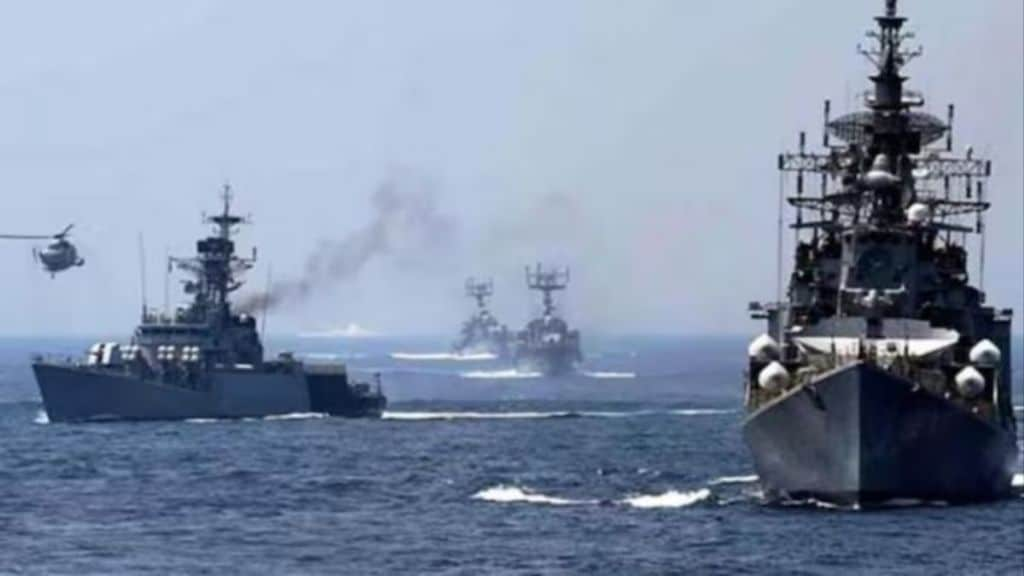By Anita Inder Singh
An unprecedented mix of multiple political, security, and economic reasons will make the Indian Ocean a zone of global and regional seapower contest and economic competition in 2024. They include the Israel-Hamas war, drone and missile attacks by Yemen’s Houthis on commercial ships in the Red Sea area, and the retaliatory Anglo-American strikes on Yemen. As conflict escalates in the Gulf of Aden, the deployment of more than 10 Indian warships in the Arabian Sea shows that India’s security and economic interests are at stake. Additionally, the China-India rivalry over the Maldives also highlights the competition between them in the Indian Ocean region (IOR).
China says the Indian Ocean does not belong to India. Geographically situated in the Pacific, China has emerged over the last decade as an Indian Ocean power from Southeast to southern and West Asia—and from there on to Africa. While competing with India in South Asia even in its immediate Indian Ocean neighbourhood, China is the major rival to the US in Southeast and West Asia.
China’s competition with India made news when President Mohamed Muizzu of the Maldives visited Beijing from January 8-13. His trip followed a diplomatic row between India and the Maldives. The tension between them may not abate soon: Muizzu said that his country cannot not be bullied. He also asked India to withdraw its troops from the Maldives by March 15.
Meanwhile, India’s navy is keeping watch on a Chinese research vessel, which is reportedly on its way to docking in the Maldives. Such a ship could be used for military surveillance. Malé says the ship will only make a port call “for rotation of personnel and replenishment”.
Beijing’s state-steered Global Times lambasted India’s tracking of Chinese vessels as “a reflection of India’s ‘arrogant and domineering diplomacy’”. By contrast, it claimed that China has always treated the Maldives as an equal partner and respected its sovereignty. Economic ties between the Maldives and China are expected to grow under the auspices of China’s Belt-and-Road Initiative.
Further afield, in the western part of the Indian Ocean, since late November, the Israel-Hamas war and the attacks on commercial ships by Iran-backed Houthi rebels in Yemen have, in the Bab-el-Mandeb Strait (which lies between the Arabian Peninsula and the Horn of Africa), put to rest any chance of the India-Middle East Corridor taking off. This does not suit India. Prime Minister Narendra Modi wanted the India-affiliated IMEC to be the basis for world trade ‘for the coming centuries’. Now, its mere take-off could be a pipe dream.
In the Red Sea conflict area itself, China’s political security and economic interests are at issue. China has a military base in Djibouti, which is strategically situated by the Bab-el-Mandeb Strait. It separates the Gulf of Aden from the Red Sea and guards the approaches to the Suez Canal. The Red Sea and Suez Canal are vital international trade channels for Chinese and Indian trade with Europe, Africa, and the US. Moreover, the cost of global trade has risen sharply because of the Houthi attacks on shipping in the Red Sea area.
In March 2023, China brokered an agreement between Saudi Arabia and Iran and persuaded them to establish diplomatic relations after a gap of several years. That accord may be in tatters now. The Iran-supported Houthis overthrew a Saudi-backed government in Yemen in 2014. At the moment, there is little chance that China will be able to dissuade Iran against arming the Houthis.
China would like the US to make moves to settle the Israel-Hamas conflict. As long as that war continues, there is little hope of ending the armed conflict in the Red Sea area. For the moment, China blames the US and Britain for launching military strikes on the Houthis and exacerbating the crisis in the Middle East. The Red Sea is now yet another arena in which the global Sino-American “great game” is being played.
Then there is China’s African interest in the Indian Ocean. This also highlights its competition with India. In keeping with a tradition spanning over three decades, China’s foreign minister Wang Yi embarked on his first annual overseas trip to African countries between January 13 and 18, reinforcing China’s diplomatic ties with four of them, including Egypt. He visited Egypt for the second consecutive year. Egypt-China trade hit $16 billion in 2022. In contrast, India-Egypt bilateral trade amounted to $5.175 billion from April 2022 to January 2023. Evidently, China plays a stronger economic card than India in the Suez-Red Sea region.
While on a trip to Nigeria, on January 23, Union minister for external affairs S Jaishankar voiced confidence in India’s ties with Africa, saying that a new global order would only emerge “when the core of it is economic … the rise of Africa has to be the economic rise of Africa.” Trade between India and Africa was estimated to be around $ 82.53 billion in 2021-22, while China-Africa trade touched $282 billion.
The reality is that several countries are involved in armed conflict in the IOR, and China is in a fairly strong position in Africa and the Maldives. This situation is antithetical to India’s hopes for a region where security rests on the balance of power rather than war or dominance by any single country—whether that is the US or China. New Delhi must live with strategic and economic uncertainty as it keeps watch on the direction the balance of power will tilt.
Anita Inder Singh, founding professor, Centre for Peace and Conflict Resolution, New Delhi. Views are personal.


